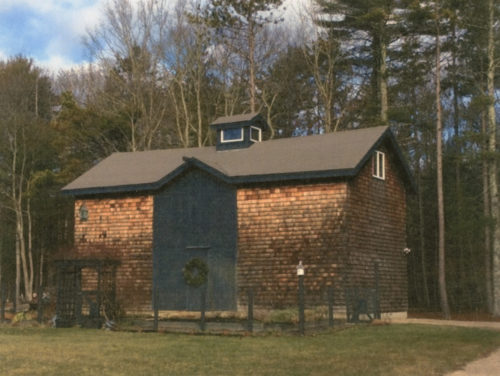
Donors
Their talent made our world more beautiful - their gift will keep it going
Peggy Warner is putting the finishing touches on her “new” studio—she has converted the Icehouse on the Farm in Exeter, where she lived for 32 years with her renowned architect husband, Bill Warner* until he died in 2012.

“C’est fini!” she recently wrote to a friend. “I finished the restoration of the Icehouse, which was moved from its location on the mill pond to the hayfield in 2004 to build a basement under the footprint for our new house. We loved the proportions and the location so much that we poured a foundation and left it at the northern edge of the western hayfield. It was filled to the brim with ‘thangs’ for 16 years, pieces of interiors, and office furniture from 10 buildings we had renovated on the farm. In 2020, I had a carpenter raise the roof six inches in the middle of the ridge. I started replacing the red cedar shingles and windows in 2021, and this year, the interior was designed by me and built by my carpenter. It is a three-season art studio for me. No heat or AC, no plumbing. Just a source of well water and a sink for watercolor boards and coffee. I only bought wood and labor and paint, new lamps and pendants. Everything else I had repurposed from my house and the office. The electrician and carpenter packed their equipment and rolled down the drive, finished June 30. Will be sending photos shortly. Probably one at a time...”
Needing something to go forward with after Bill died, she decided to return to her own art roots. As a young artist, Peggy spent the first six months after graduating from the University of Illinois as an art teacher and decided she didn’t like teaching art.
She made her way to Princeton, NJ, spent a summer there running an art gallery, then sold her watercolors, making a living for four years selling them at art festivals in the region, a co-op, and even had a one-woman show in Princeton.
Peggy also had experience as a theater set painter, which brought her to Providence. During her summers in college, she had worked with Bob Soule—a friend, mentor, and resident set designer at Trinity Rep— in summer stock theater in Illinois. “He said he needed someone in Providence right away. ‘Can you come and be here in one week?’ I took the leap, getting older, single, sublet my apartment in Princeton, and moved to Providence.” She worked with Soule, Eugene Lee, and Adrian Hall for four years painting sets for Trinity and spent all her time at the theater, which is where Bill came into the picture. “We were working on Night of the Iguana by Tennessee Williams. He asked me out to dinner, and I moved to the farm a month later—we just fit.” A year later, wearing a red dress, she married him on the State House steps under the words ‘a lively experiment.’
“I had no time for my own painting anymore, basically worked closely with Bill full time for the architecture firm.” She was just 30 when they met and worked with him until he closed the office in 2011. “Since he died, I have been organizing 52 years’ worth of papers and drawings and models.”
And last year, Peggy established the William D. and Margaret H. Warner Legacy Fund at the Foundation, leaving a bequest to support organizations engaged in urban planning or community development. “I want the community to benefit from our work in urban design.”

A few of Peggy’s early watercolors are displayed in her new studio. A grouping of antique farm tools hangs from one wall next to an old barn door. The wood inside is original. A paint room with a custom- built curtain system for encircling her and the canvas so she’s free to throw and splatter the paint. A staircase and a loft stabilize the entire building. Boxes and boxes of old paint tubes. “I don’t know if they’re good anymore. Will the tubes burst when I squeeze them?
“I don’t even know where I’m going with my painting. I’m not going to show it to anyone. No deadlines, no TV, no phone. I think this space is special—it gives me hope that I can do something worthwhile here.”
*William D. Warner (1929-2012): Warner’s enduring legacy is Providence’s River Relocation and Waterplace Park Project, for which he received the 1997 Presidential Design Achievement Award from Bill Clinton. He was also responsible for the I-Way Bridge across the Providence River, the Rt. 195 Relocation Project, redesigning the Manchester Street Station power plant, the redesign of India Point Park, and his first big job in the city, in 1959, heading the Providence Preservation Society’s study that resulted in the restoration of College Hill.



